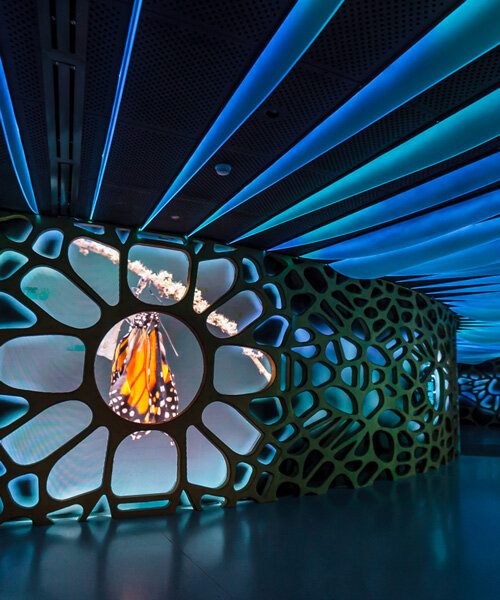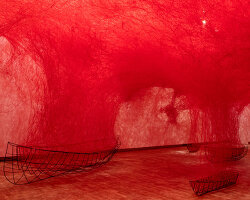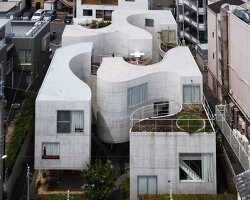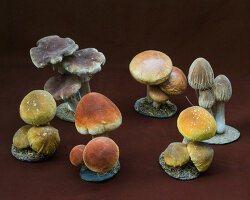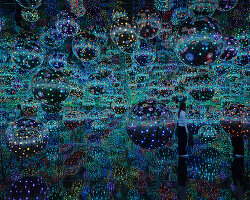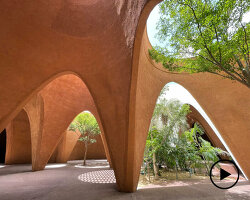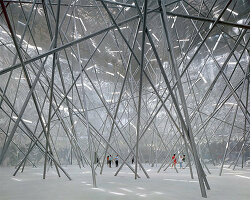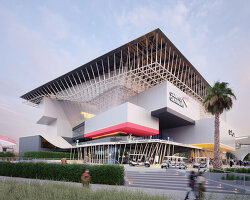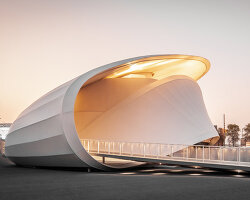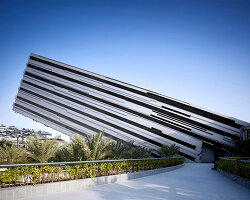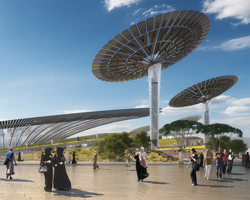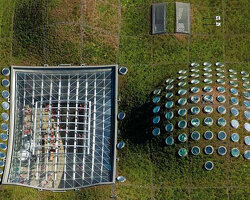with expo 2020 dubai set to open later this year, anticipation is building ahead of the event. one of the site’s most significant buildings is ‘terra’ – the sustainability pavilion, which was designed by grimshaw with exhibition design by new york-based studio thinc. supported by the direction and vision of the expo team, thinc developed the exhibition storyline and environments in collaboration with eden — the firm who worked on the original eden project in cornwall, england.
following the successful opening of the pavilion for a three month showcase, the first images inside terra have been revealed. to learn more about the much-anticipated exhibition, designboom spoke with tom hennes, thinc’s founder and creative director, and marjan faraidooni, chief experience officer of expo 2020 dubai. ahead of the expo’s opening in october 2021, read their thoughts below and take a walk-through of the exhibition with photos taken by tom hennes himself.
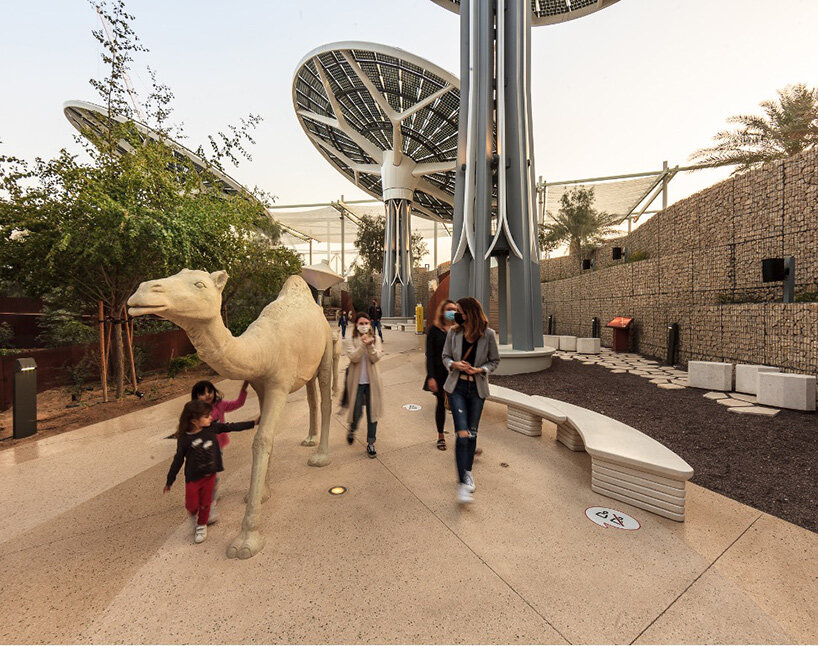
entrance – the wadi: visitors enter through a wadi — a dry riverbed — that traverses thousands of years of changing climate in the arabian peninsula. the sculptures and footprints show animals now extinct in the region — elephants, ostriches, and cheetahs—as well as some of those present today. a portion of the exhibit features adaptive cultural objects of the bedouin, who have lived sustainably in the desert since time immemorial | all images © tom hennes
designboom (DB): can you start by telling us about your role as part of ‘terra – the sustainability pavilion’ at expo 2020 dubai?
tom hennes (TH): thinc is the exhibition designer. we developed the exhibition storyline and environments in collaboration with the eden project, supported by the direction and vision of the expo 2020 team.
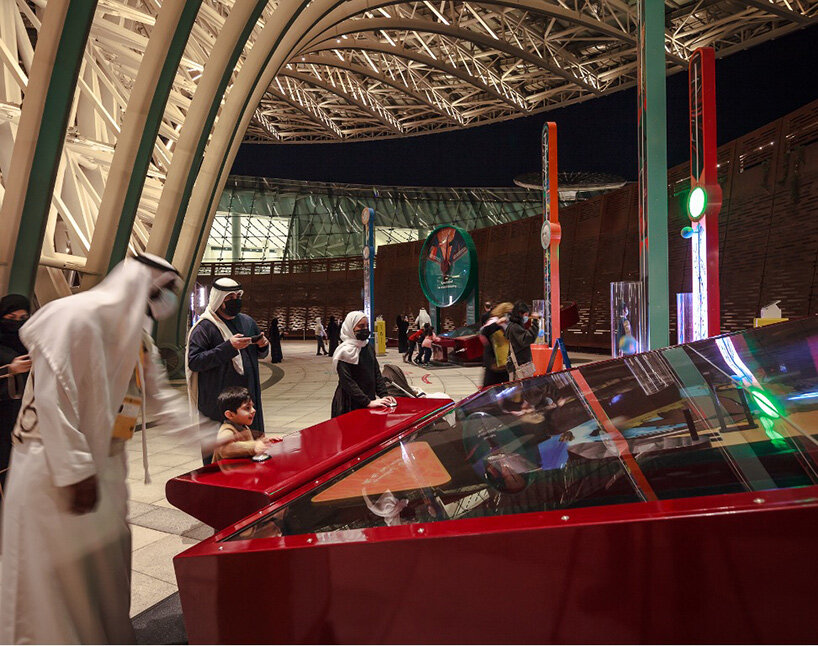
the courtyard
DB: what sort of research did the thinc team do before starting on the design of the exhibits?
TH: eden brought a wealth of environmental and sustainability expertise and a host of research partners to the table. thinc took the lead on the design and integration in the building, with eden taking the lead on developing the exhibition content. both of us have a long record of environmental projects. thinc primarily develops natural history museums, aquariums, and zoo exhibitions.
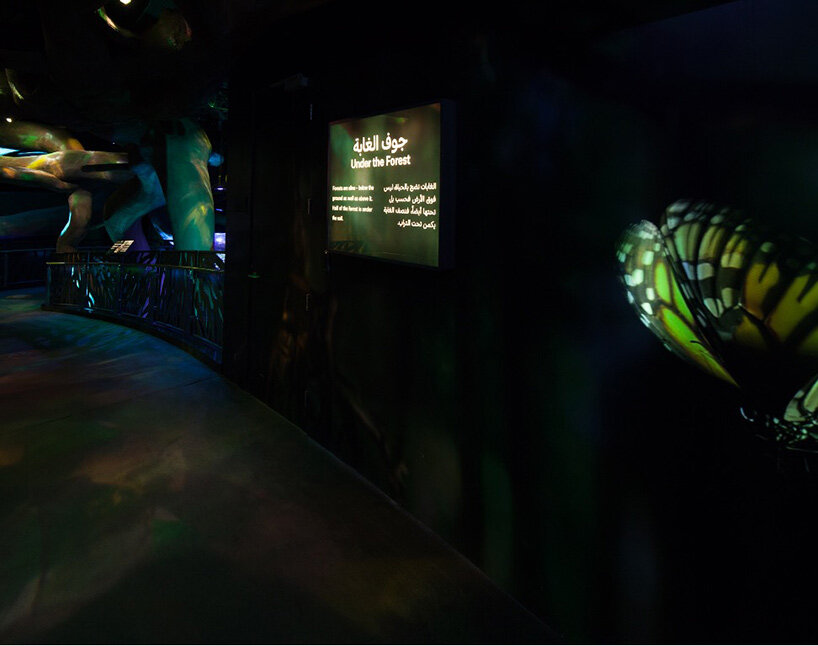
under the courtyard: ‘under the forest’ is one of the two environmental immersions in the wonder of our living systems. an animated butterfly, enlarged and slowed to reveal the beating of its wings, greets visitors as one of the characters they will encounter again and again throughout the experience.
TH (continued): eden has developed the original eden project, which transformed cornwall with the conversion of an enormous former clay mine into the largest indoor rainforest in the world. it has since worked on a variety of other projects. we spent a great deal of time visiting different sites in the UAE and speaking with conservationists, innovators and researchers at masdar city, among others, and we worked with the expo 2020 team to make sure the UAE environment and local species were represented across terra’s exhibits.
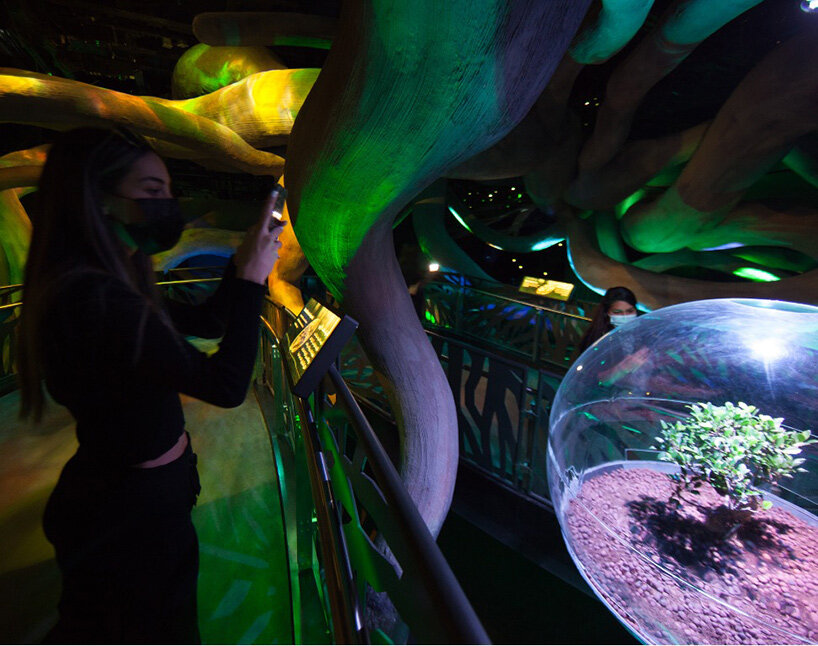
guests plunge into the tangled roots of a vibrant forest to discover that they are alive with communication and the sharing of nutrients. this living bonsai tree is a reminder of the fragility, the resilience, and the beauty of living things.
DB: how closely did you work with grimshaw, the building’s architect, to develop the exhibits as part of the overall pavilion design?
TH: thinc was part of the grimshaw team from the beginning. we worked hand-in-hand with them as they developed terra’s design, which not only involved the final configuration of the exhibition spaces, but also conceiving and executing the exhibits to fit within expo’s strict net-zero power requirements for terra.
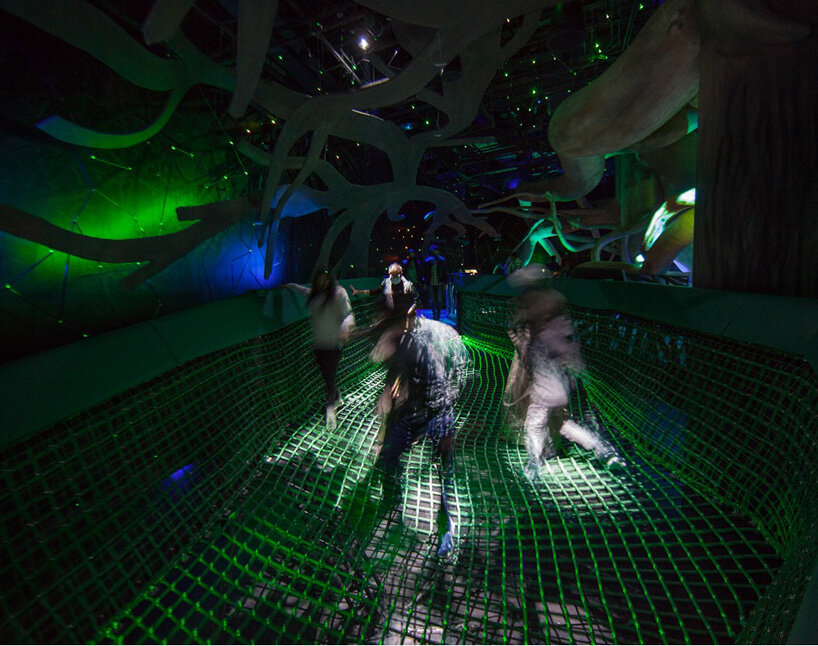
the ‘wood-wide network’ is a communications net formed by an intricate collaboration between plants and fungi. this net connects visitors who walk across it with sparkling energy and light triggered with every footstep.
DB: in what ways do the exhibits communicate the main themes of the expo?
TH: expo 2020’s main theme ‘connecting minds, creating the future’ is the starting point for terra. we live on a marvelous planet, filled with wonder that is threatened by the way we use its resources. by reconnecting to that sense of wonder, and by thinking through what it is we really value, we can come together around common aspirations, and conceive of new ways of living and better ways of making our future. if we notice the world around us, and we grow more aware of what it is we truly value, we can work together to shape a planet we will all want to be a part of.
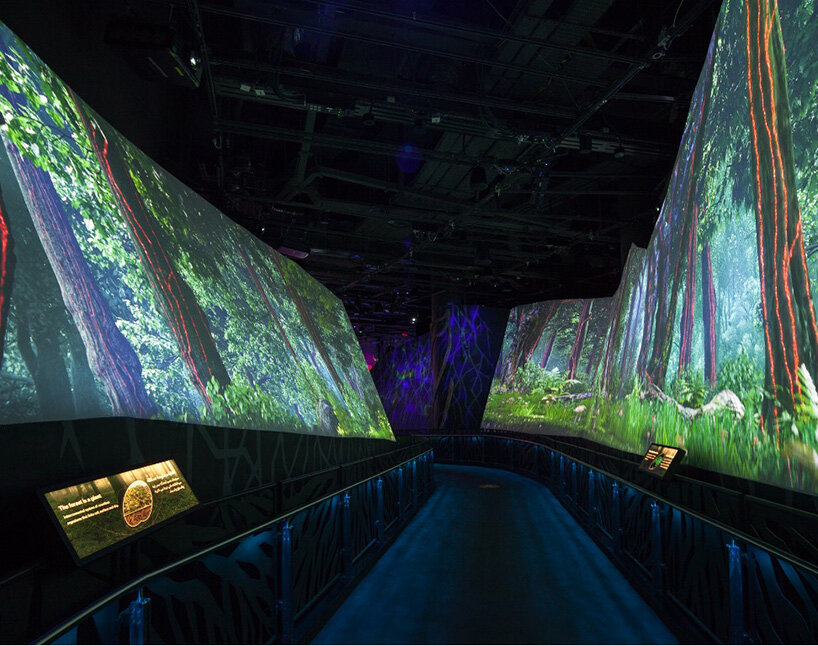
immersive ramps under the ocean: visitors descend through an immersive, animated forest that reveals the vast network of communication and nutrient sharing among the tangled roots of trees. this ‘wood-wide web,’ part of the unseen wonder of the natural world that is threatened by our vast culture of consumption, is also resilient and able to restore itself if humans give it half a chance.
TH (continued): that was the point of departure. we shared an aspiration with both the expo leadership and eden to use the pavilion — and the world coming together at expo — to explore new and better ways of drawing people more deeply into an exploration of sustainability than anywhere else and inspiring innovation in how we tackle sustainability and communicate about it publicly. working together with eden, we created a journey through fantastic environments that are wondrous, engaging and playful.
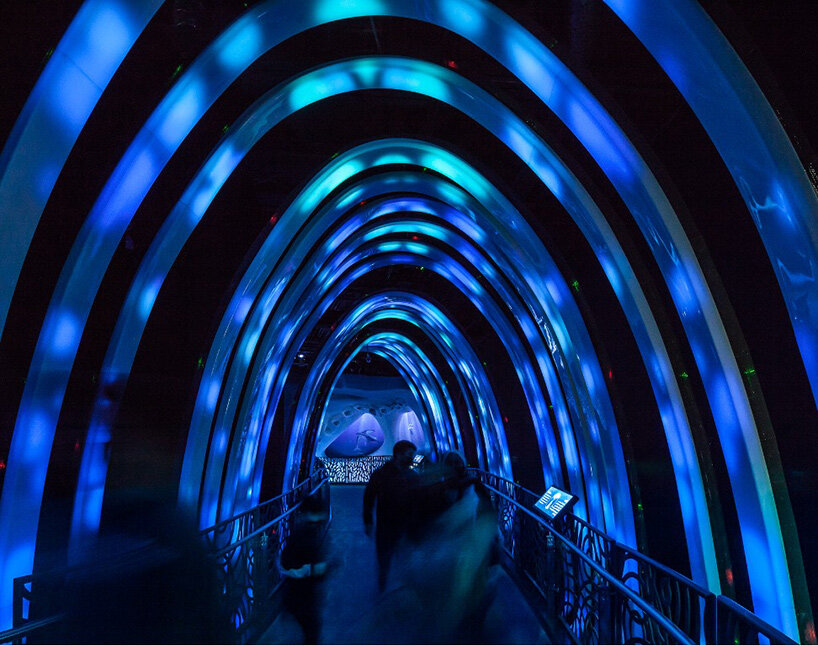
under the ocean: guests can join in, echoing the whale songs that travel thousands of kilometers throughout the oceans. these ‘whale ribs’ transmit a dynamic visual signal from the sounds that guests make in the space.
TH (continued): playfulness isn’t usually associated with sustainability. but working from our own base of experience and an extensive body of research on how people shape their attitudes and actions toward the environment, we saw this as a way to lower barriers and draw people into a more thoughtful and eye-opening engagement with sustainability and their own relationship with the planet. this meant turning up the volume on wonder, peering in and literally walking into hidden marvels amid the roots of a forest and descending into the ocean and finding surprising connections (connecting minds) there.
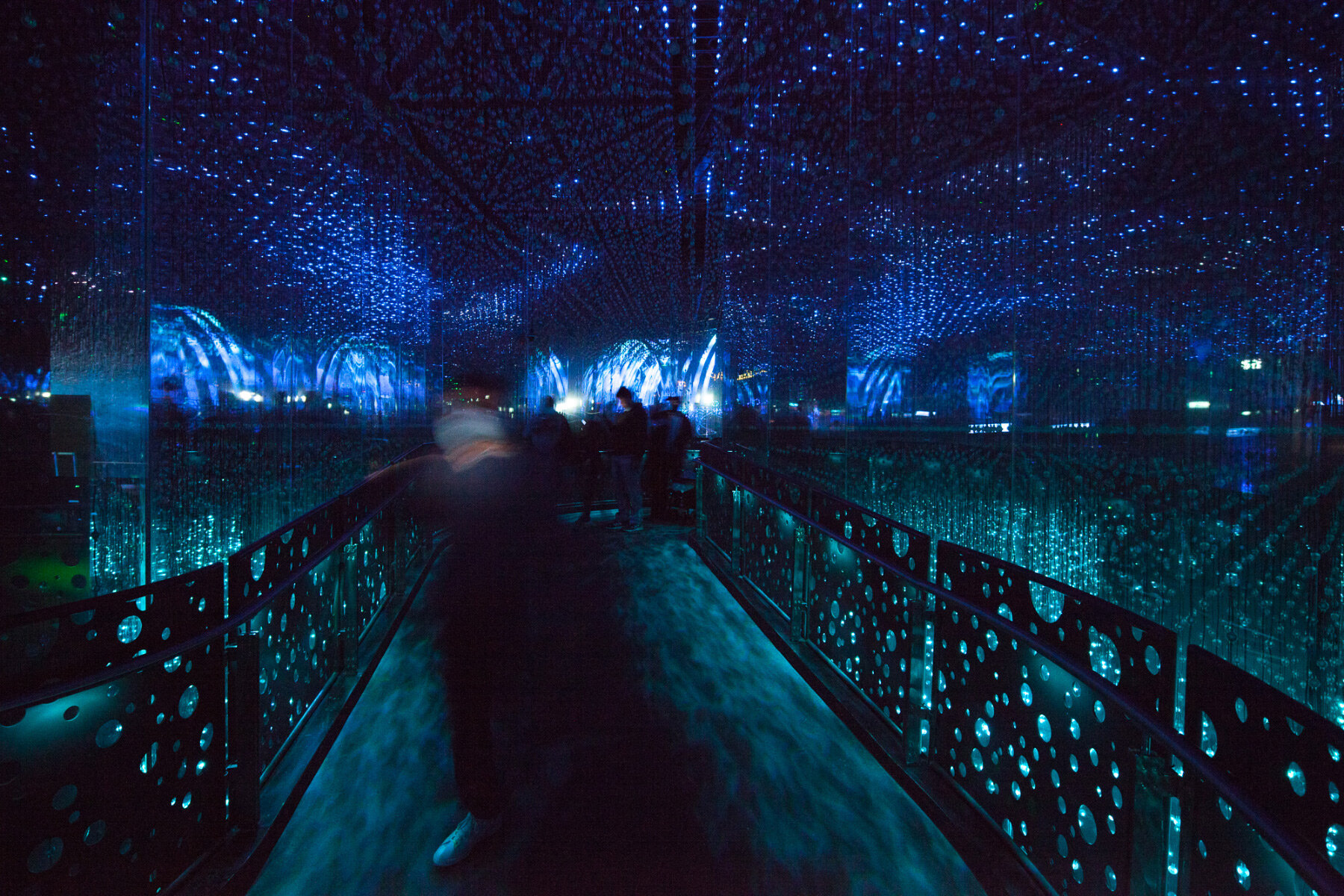
in the deepest ocean, there is no light except for the bioluminescent glows of the animals that live there. this infinity space of light and mirrors fills with the twinkling movements of deep sea creatures and the mysterious sounds of the depths.
TH (continued): it meant holding up a mirror to the waste and destruction of our consumerist cultures in a way that brings recognition through its larger-than-life depiction of a topsy-turvy world gone mad — letting visitors stand both outside (‘wow, this is really crazy!’) and inside (wow, this really IS crazy.’) it meant giving everyone who walks through the door a chance to consider what’s important to them, to make choices and see what others choose. finally, it meant providing a showcase of fantastic initiatives that people are creating all over the world to make real changes for the better (creating the future).
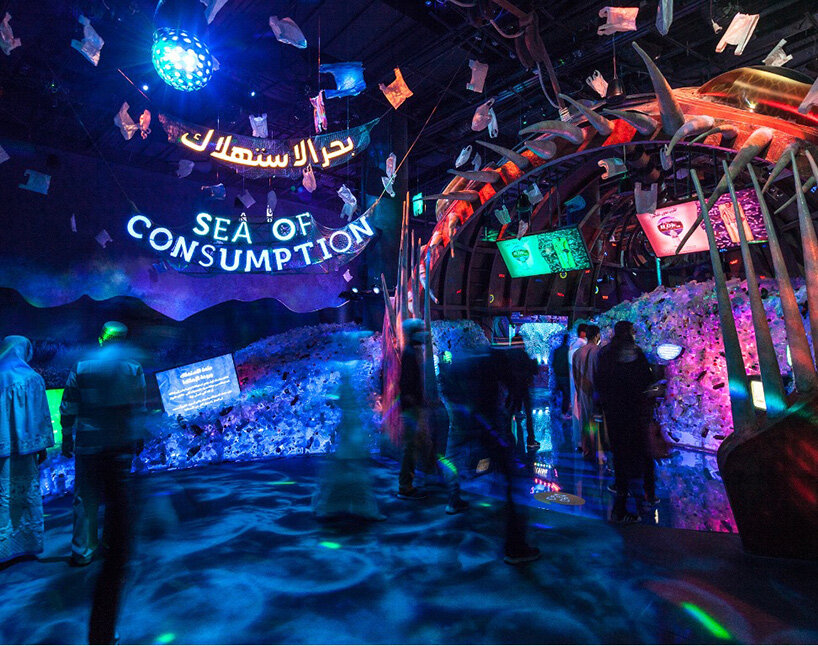
consumption hall: the ‘sea of consumption’ dramatizes the impacts human activities on land have on every corner of the world ocean. the open mouth of a giant angler fish — choked with plastic refuse and discarded tvs that still play consumer advertising — is our portal into this remote and rapidly changing world.
marjan faraidooni (MF): terra will bring to life the UAE’s and expo 2020’s commitment to sustainability, taking millions of visitors on an immersive journey through the wonders of the natural world and inspiring them to create a cleaner, safer, healthier future. its emotive visitor experience, developed in close collaboration with thinc and eden, tells the enchanting story of humankind’s relationship with nature, while addressing negative environmental impacts, caused in large part by human behavior — helping visitors, the younger generation in particular, to understand their impact on the environment, break the cycle of consumerism, and become agents of change.
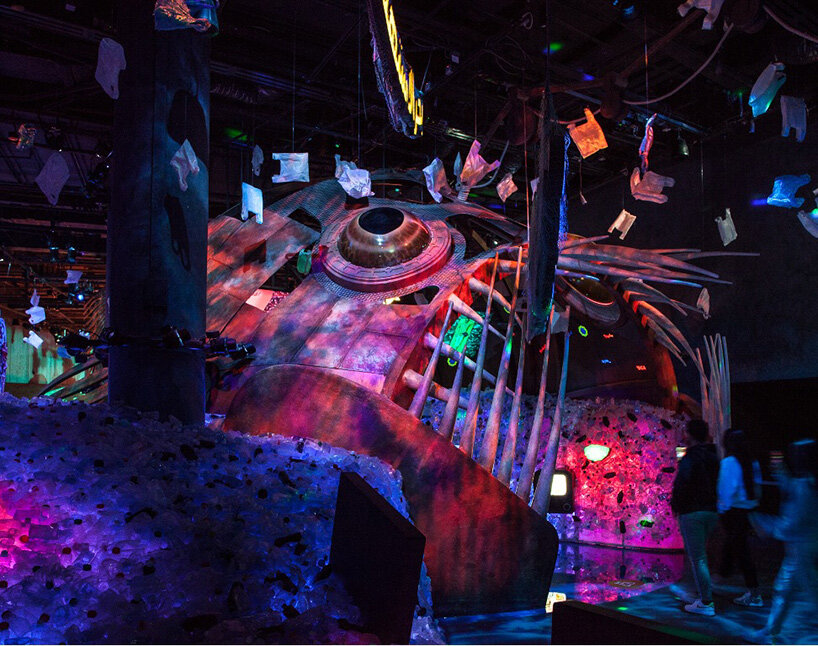
angler fish: the angler fish — a species that lives in the deepest, most remote depths of the ocean — is surrounded by an ocean of plastic refuse. it symbolizes the way even these distant parts of the planet are profoundly affected by what humans do on land.
MF (continued): the pavilion itself is a testament to its theme, setting a benchmark for sustainable building design. this will extend into expo 2020’s post-event legacy, when it will become a children’s science centre in district 2020 — the new city that will evolve from the expo site — inspiring sustainable choices for generations to come. in legacy, the sustainability pavilion aspires to be a self-sustaining building generating 100 per cent of its energy and water supply.
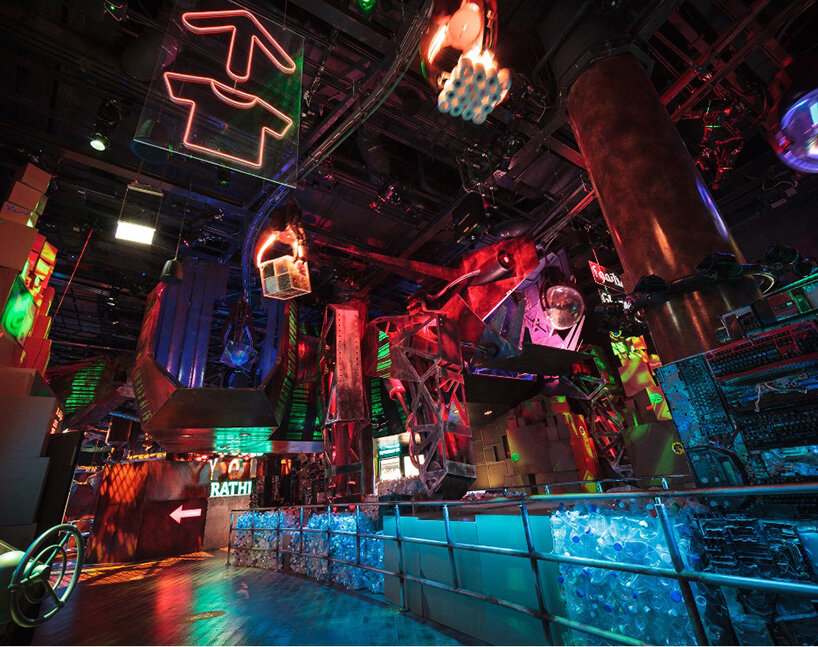
the gnasher: nature in, products out. the gnasher is our global engine of consumption, eating the wonders of nature fed to it by the overhead conveyor above and to the right in the image, and converting them to the sometimes useful and often wasteful products that power human society, exiting the machine on the conveyor above and to the left. surrounded by piles of waste and even higher piles of unsold goods, it dramatizes the damage that heedless economic growth can wreak on natural systems.
DB: how have you used digital environments to reinterpret the natural systems of earth and human life?
TH: as a team, we have favored environments and interactive elements that blend the physical and the digital. the pavilion is much closer to a theatrical environment than it is to a museum; there are lasers, there is immersive media, but there is also an abundance of sculpted physical spaces, models and even puppet characters throughout.
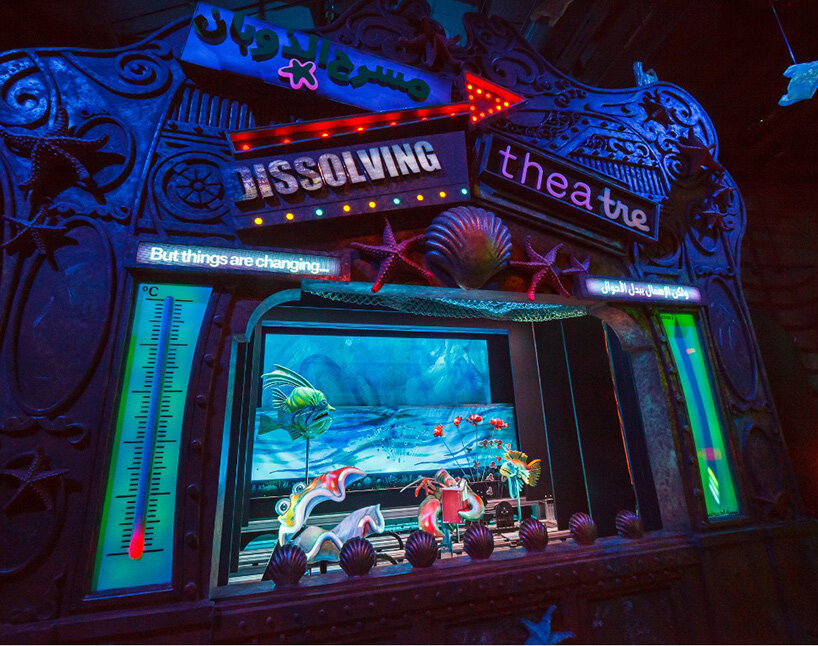
dissolving theatre: the dissolving theatre tells the story of the acidification and warming of the ocean, as it absorbs atmospheric carbon emissions from countless sources that power our life on land. whimsical mechanical puppets draw guests into a simplified rendition of a very complex global phenomenon to make it understandable and set up some of the choices guests will encounter later on.
TH (continued): our goal with this blended media is to create delight, as well as charm — something rarely encountered in places such as this — to open hearts. to seriously engage with something as mighty and daunting as global sustainability, we must have open hearts. people act based on how they feel — on the basis of emotional connections and the things they identify. they choose facts and information based on those feelings, not the other way around. so, if we hope to engage people in constructive dialogue about sustainability and about the future of this planet, we must begin with the way they feel.
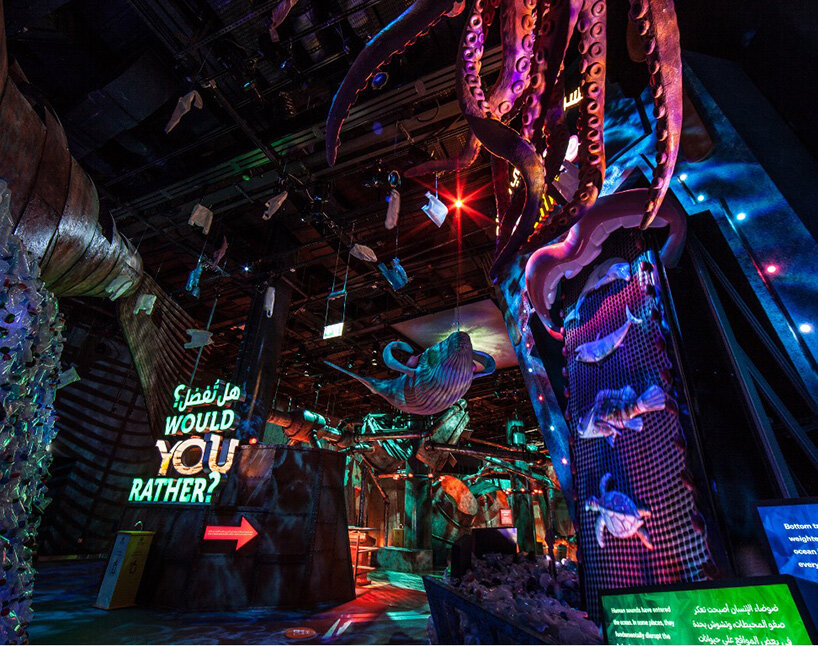
would you rather?: amid the calamity of our seemingly boundless appetite for the bounty of the oceans and our ongoing assaults on its ecosystems, the values we hold and the choices we make can chart a path toward environmental degradation or regeneration. beneath the sculpture of a whale, deafened by the noise of ships, explosions, and other underwater sounds made by human industry, ‘would you rathers’ present guests with choices that can change the course of our world.
TH (continued): the way this manifests in the exhibition is through a constant interweaving of playfulness, wonder and information. the physical spaces provide much of the playfulness and wonder, though some of the models and puppet elements also communicate very challenging truths. digital media at terra includes a wide range of immersive environmental videos and animations that reveal the hidden workings of nature (and particularly the hidden connections among all living things) and provide deeper information to support the experience.
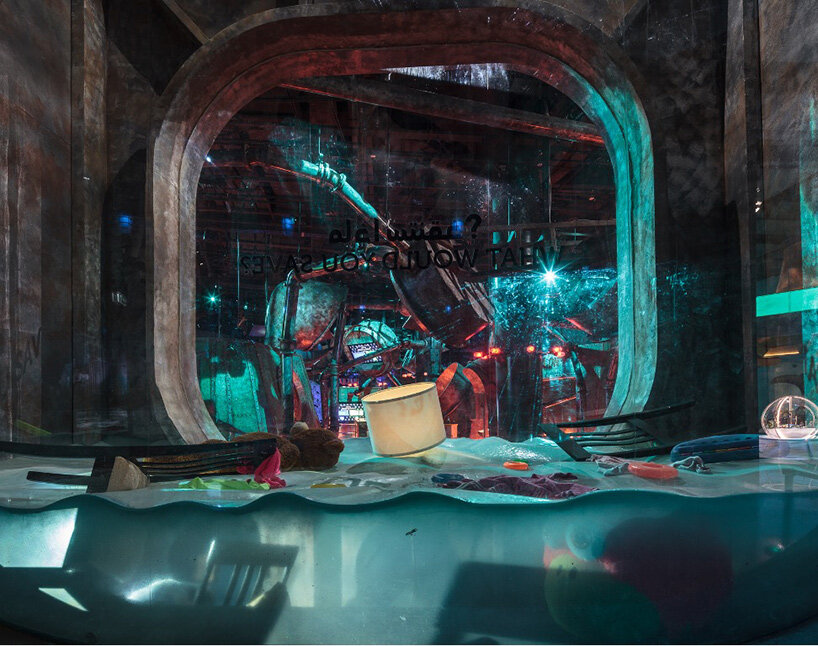
the flooding house: it is easy to lose focus of what each of us most values. under the ocean leads to a depiction of a flooding ‘house’ in which the detritus of modern life floats in an abandoned wasteland with the question hanging overhead: ‘if your house were flooding, what three things would you save?’
TH (continued): digital media also provides portraits of engaged people from around the world who are making differences — large or small — in their communities, countries and regions. we have also included numerous opportunities for expo guests to insert their own stories, their own wisdom and their own aspirations for the future.
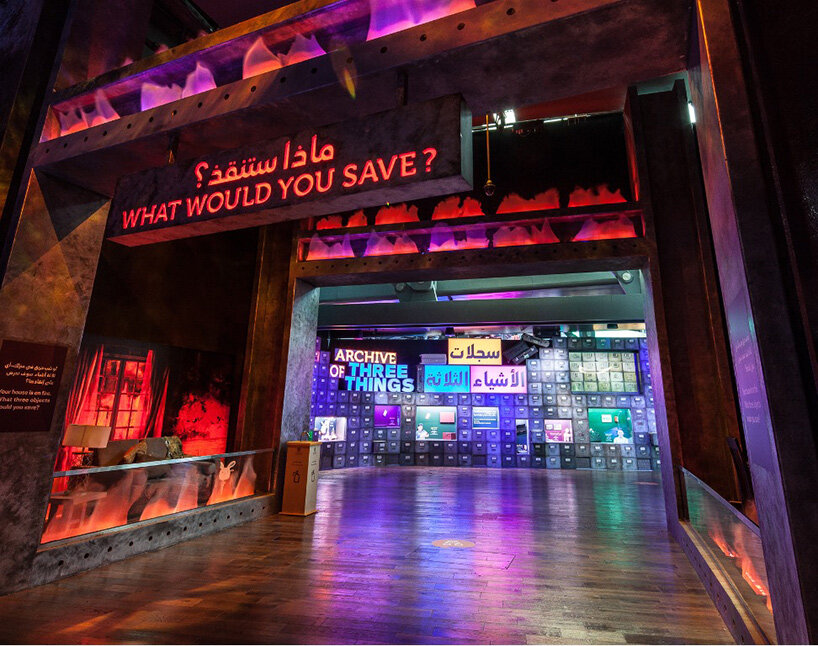
what would you save?: the land-side exhibits lead to a depiction of a burning ‘house’ in which the flames consume the everyday remains of our domestic life. asking ‘what would you save?’, the burning house leads to the ‘archive of three things’, which houses a selection of answers offered by people around the world.
MF: the digital environment is a crucial aspect of terra’s visitor experience, which has been designed to make the fundamental issues around sustainability more personal — to ensure people care about it and directly relate it to the choices they make in their everyday lives. we want them to feel moved, excited, passionate, and maybe a little bit uncomfortable by their experiences, so they leave the pavilion inspired and committed to make a difference.
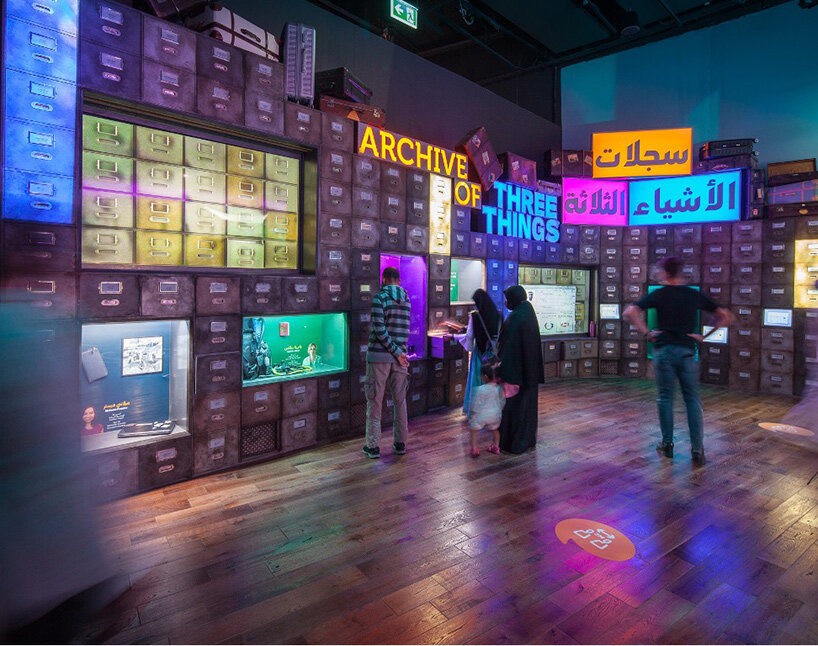
the archive of three things: stacks of drawers labeled with the names of contributors hold examples of the objects people from around the globe would save from a burning or flooding house. they reflect the value of community, family, and memory much more frequently than monetary value, and spark many conversations among guests about what they themselves most value and call into question the way we impact our planet in the name of consumerism. guests have the chance to enter their answers on tablets placed throughout the exhibit.
DB: is there one aspect of your design or involvement that you are particularly proud of?
TH: terra is an adventure and a journey into our planet and ourselves that is unlike anything elsewhere in the world. the collaboration with eden and with grimshaw, driven by the vision of the expo team to create a unique visitor experience, has produced a journey that blends fantastical environments, great storytelling, deep science, and a very human experience that, from early observation and response, moves people deeply and changes the way they understand their world.
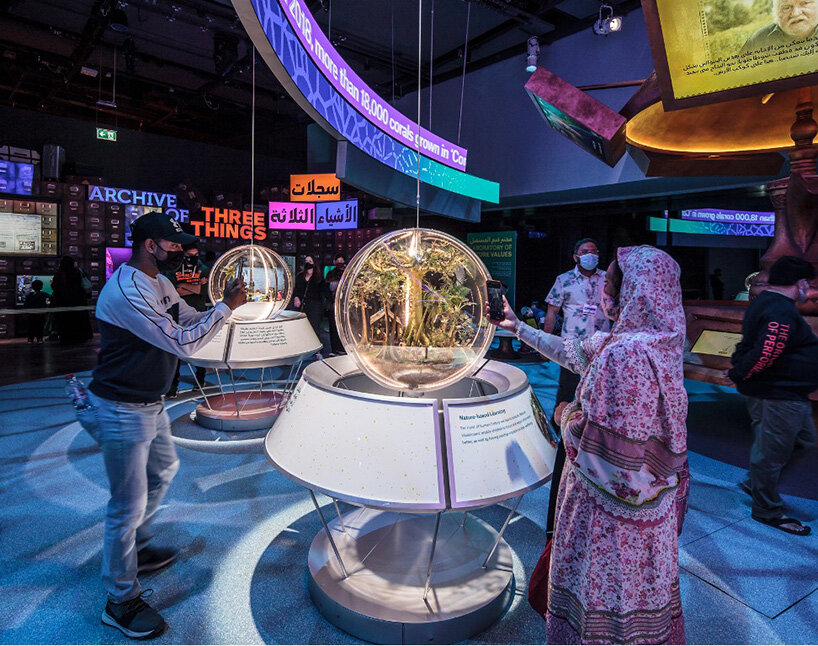
the laboratory of future values: intricately modeled ‘microcosms’ that depict regenerative projects around the world share valuable lessons and provide a sense of hope and possibility for restoring the health of the planet that supports our own species’ health. clustered in themes that include education systems, marine regeneration, terrestrial health, and the health of the microbiomes within our own bodies, the different areas are connected by vibrant overhead ribbons of light that transmit news, ideas, and a world of perspectives.
DB: has this project, and your research into its themes, impacted your other work as a studio?
TH: absolutely. it has freed us to utilize a much broader palette of experience when we create serious exhibits about serious subjects. we recognize more fully how engaging people in play — perhaps especially around a subject as challenging as environmental sustainability — can open them to a more thoughtful, deeper consideration of how they want to live in the world and how they actually can live in the world. in other words, by engaging people in the fuller emotional and intellectual universe this kind of exhibition provides — of wonder, humor, compassion and hope — we can offer them greater freedom to move, to innovate and to imagine, than they might have ever thought possible.
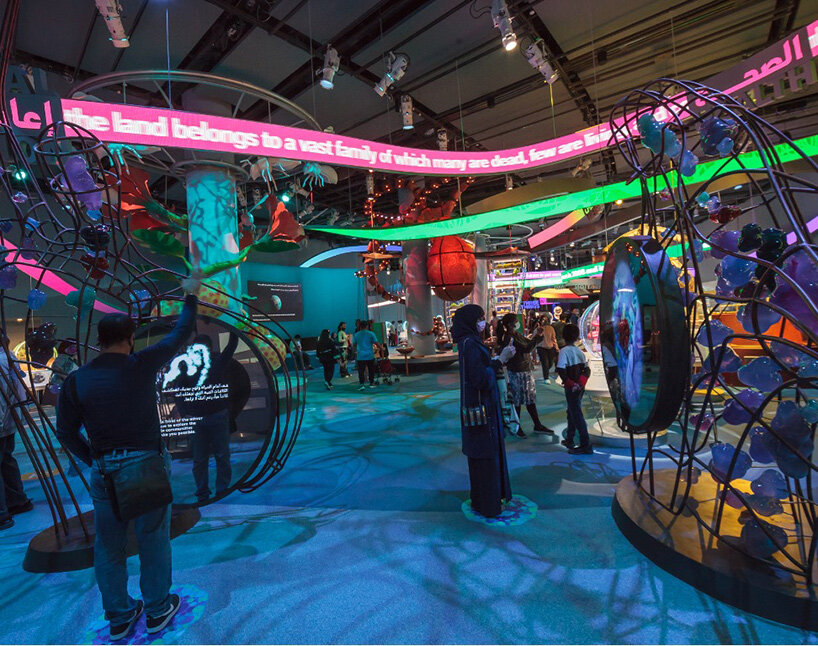
sculptural evocations of human figures hold mirrors that come to life when guests gesture toward them. they show the hidden, ecosystem of our microbiome — thousands of microscopic species and billions of organisms that live within us and make our lives possible.
DB: what do you hope that people take away from visiting the sustainability pavilion?
TH: we hope they come away with a renewed love for this earth and a fuller sense of wonder at all that this living planet is and does for us. we hope visitors get a chance to feel both the thrill of earth’s life and the madness of so many aspects of the consumerist culture that dominates our world today. we hope they come away with a deeper awareness of what they really care about. and finally, we hope they come away with a powerful sense of possibility and hope — that each of us, especially all of us together, can create a future in which human life thrives on a thriving planet.
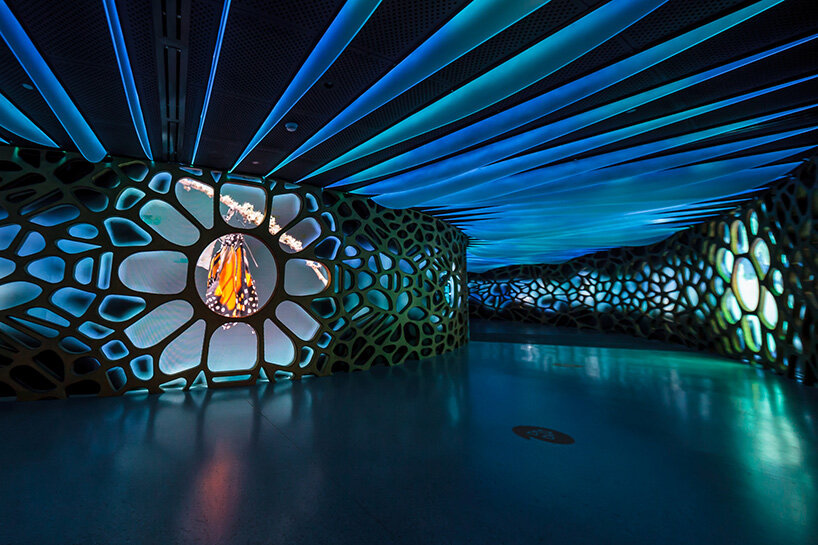
the outer core: the butterfly that greeted guests who entered through the forest roots returns in this interconnected web of life that brings the concept of ecological regeneration to life. this ring-like passageway around the very center of ‘terra’ — the place from which its massive solar canopy spreads its arms—draws vivid examples of environmental regeneration into a dynamic, luminous space that pulses with the interconnectedness of life.
MF: terra’s engaging, playful and personal experience means that all visitors — and children in particular — understand their impact on the environment and are inspired to create a safer, cleaner, healthier future. and it’s working. when we opened terra’s doors to the UAE community for a limited-time showcase between january and april 2021, more than 100,000 people attended — and more than 90 per cent of those surveyed said the experience had inspired them to change their behavior, from saving water to making a conscious effort to use less plastic. it is these small, individual actions that can lead to big changes and lasting, positive impact.
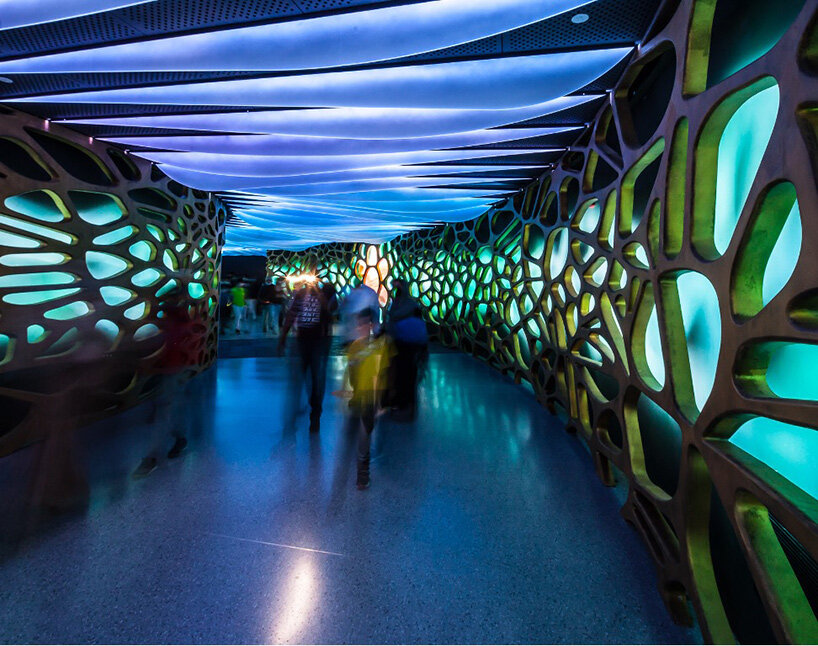
surrounded by vibrant examples of environmental restoration and regeneration, guests exit through the glowing environment of the outer core.
exhibition design (648)
expo 2020 dubai (53)
thinc (3)
PRODUCT LIBRARY
a diverse digital database that acts as a valuable guide in gaining insight and information about a product directly from the manufacturer, and serves as a rich reference point in developing a project or scheme.
